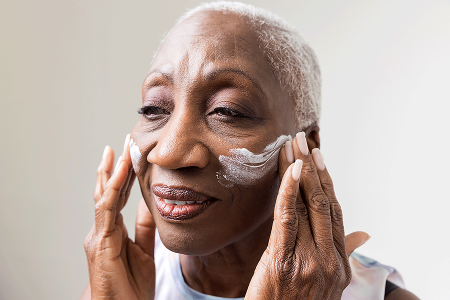Cutaneous T-cell lymphoma: Relief for skin problems
If you have cutaneous T-cell lymphoma, your skin is dry and fragile. This means you’re more likely to develop open wounds and skin infections.
Your skin can also be intensely itchy, and scratching increases your risk of developing open wounds and infections.
The right skin care can help your skin feel better. Most importantly, it can reduce your risk of developing a serious and sometimes life-threatening skin problem.
Here’s the skin care that dermatologists recommend for people who have cutaneous T-cell lymphoma.
Use the skin care products that your dermatologist recommends. If you’re seeing a dermatologist, your dermatologist will recommend a moisturizer along with other skin care products. Using the recommended products will help prevent a skin care product from irritating your fragile skin.
Treat dryness and scale with moisturizer. If you notice these on your skin, apply your pH balanced, fragrance-free moisturizer. Apply it liberally to the dry, scaly skin after bathing and as needed.
If you have been diagnosed with Sézary syndrome and still notice dryness and scale after using moisturizer, tell your dermatologist.
Using a gentle, pH-balanced, and fragrance-fee moisturizer also reduces your risk of developing a serious skin problem like a skin infection.Use a moisturizer that is a cream or ointment, pH balanced, and fragrance free
Lotions contain too much water to effectively moisturize your skin. A gentle, pH-balanced, fragrance-free moisturizer that contains petrolatum is a good choice.

Use moisturizer as directed. Here’s what dermatologists recommend:
- When treating cutaneous T-cell lymphoma with medication that you apply to your skin, you often will see instructions for when to apply moisturizer. If you don’t see these instructions, ask your doctor about how to use the medication with moisturizer. Sometimes, moisturizer causes medication side effects or prevents medication from working.
- Apply your moisturizer after showering and as needed throughout the day. Showering and washing parts of your body like your hands can strip natural oils from your fragile skin. Applying your moisturizer to damp skin helps lock in water. This can help your skin feel more comfortable.
When washing your hands, taking a bath, or showering, use warm water. Hot water is especially drying to your skin, so it’s crucial that you stop using hot water.
Use your hands to gently wash your skin. Washcloths, buff puffs, loofahs, sponges, and brushes are too rough for your fragile skin. Any of these can irritate your skin or contain bacteria that could cause a serious skin infection.
Wash with a gentle cleanser that is pH balanced, moisturizing, and fragrance free. Many cleansers, soaps, and body washes contain ingredients that can strip your fragile skin of natural oils, which can worsen symptoms like itch and pain. That’s why it’s essential to use the type of cleanser described here.
Take five-minute warm showers. Water dries your skin. The longer your skin is wet, the drier it becomes. To protect your skin, dermatologists recommend taking a five-minute shower in warm or cool water and only when you need to wash.
Pat your skin gently dry after showering, leaving a bit of water on your skin. This gentle approach, followed by applying moisturizer directly to damp skin, helps to hydrate your skin and retain moisture.
Avoid anything that irritates your skin. Products to avoid include fabric softeners and laundry detergents that contain fragrance or perfume. You also want to avoid wearing clothing made of wool or polyester.
Try to keep indoor air cool and moist. Heat and dry air can irritate your skin, which could worsen symptoms like pain or itch.
See a dermatologist if cutaneous T-cell lymphoma causes a problem like open wounds, a skin (or nail) infection, or hair loss. When you have this type of cancer, a skin or nail problem can become serious quickly. Your dermatologist knows how to deliver the best possible care when this cancer affects your skin, hair, or nails.
You can find a dermatologist who treats cutaneous T-cell lymphoma by going to Find a Dermatologist. Then select:- Filters
- Any condition
- When you see the list of conditions, select Cutaneous lymphoma.
You can find a treatment center that specializes in cutaneous T-cell lymphoma at Treatment Centers and Clinic Trials.
Image
Getty Images
References
Duffy R, Jennings T. et al. “Gentle skin care guidelines for patients with mycosis fungoides.” Medscape Dermatology. Last accessed 6/13/2023.
Jawed SI, Myskowski PL, et al. “Primary cutaneous T-cell lymphoma (mycosis fungoides and Sézary syndrome) Part II. Prognosis, management, and future directions.” J Am Acad Dermatol 2014; 70:223.e1-17.
Yosipovitch G and Kwatra SG. “Cutaneous T-cell lymphoma.” In: Living with itch: A patient’s guide.” The Johns Hopkins University Press. United States, 2013: 52-5.
Written by:
Paula Ludmann, MS
Reviewed by:
Aaron R. Mangold, MD, FAAD
Elan M. Newman, MD, FAAD
Rajiv Nijhawan, MD, FAAD
Brittany Oliver, MD, FAAD
Last updated: 8/3/23
 Atopic dermatitis: More FDA-approved treatments
Atopic dermatitis: More FDA-approved treatments
 Biosimilars: 14 FAQs
Biosimilars: 14 FAQs
 How to trim your nails
How to trim your nails
 Relieve uncontrollably itchy skin
Relieve uncontrollably itchy skin
 Fade dark spots
Fade dark spots
 Untreatable razor bumps or acne?
Untreatable razor bumps or acne?
 Tattoo removal
Tattoo removal
 Scar treatment
Scar treatment
 Free materials to help raise skin cancer awareness
Free materials to help raise skin cancer awareness
 Dermatologist-approved lesson plans, activities you can use
Dermatologist-approved lesson plans, activities you can use
 Find a Dermatologist
Find a Dermatologist
 What is a dermatologist?
What is a dermatologist?
